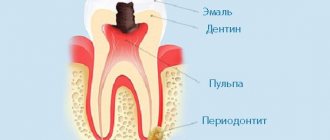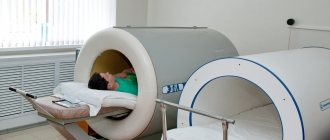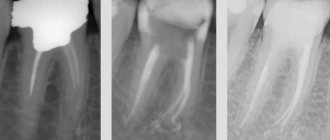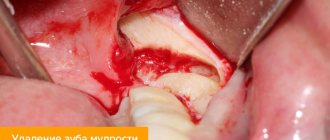Resection of the apex of the tooth root is a common tooth-preserving operation. Its essence is to remove a small part of the affected dental unit. The main indications for surgical intervention are:
- the presence of a neoplasm - cysts, granulomas, fibromas;
- violation of the integrity of the tooth root wall;
- obstruction of the root canal;
- poor quality endodontic treatment.
This procedure allows you to eliminate the source of infection, prevent inflammation and preserve the original dental unit. Let's look at how it is carried out and what complications there may be.
Natural processes
Even if the tooth extraction was “simple”, pain in the socket at the site of the extracted tooth is a natural consequence that will bother you for 3-4 days.
This is normal and nothing to worry about, but if the pain causes you severe discomfort, consult your doctor and he will recommend that you take painkillers.
Sometimes regular cold compresses applied to the cheek in the area of the extracted tooth will help relieve pain. This could be a cloth soaked in cold water or ice from the freezer wrapped in a cloth.
Tooth socket
In the case of “complex removal”, in which the gums were cut and sutured, special tools were used to gouge out the root, the pain after the procedure will be felt much longer (the doctor will definitely warn you about this), but will still gradually go away on its own.
If the pain does not go away for more than ten days, consult your doctor: there may be complications in the tooth extraction and you will need dental intervention to eliminate them.
How to treat gums at home
The basic rule of home therapy is to follow all medical prescriptions. If there is a special anti-inflammatory medicine in the inflamed area, you should not remove it without permission due to the unpleasant taste or odor. The doctor will do this himself or will tell you exactly the day and time when it is necessary to remove the medicated compress.
Dentists often prescribe soda baths. To carry them out, you need to mix a teaspoon of baking soda with a glass of warm water. Keep the solution in your mouth without rinsing. This simple measure helps to quickly remove the purulent exudate.
It is very important to follow a gentle diet during the recovery period. If there is severe pain on the first day after surgery, it is permissible to take a painkiller. If the medicine does not help or reduces the uncomfortable symptoms only slightly, you should definitely seek qualified help.
A good healing effect is provided by antibacterial gels and ointments designed specifically for treating gums. They must be prescribed by a dental surgeon.
If the operation was difficult and the likelihood of postoperative complications is high, the doctor may prescribe oral antibiotics. Typically, dentists prefer broad-spectrum drugs. It is permissible to use them strictly according to the scheme selected by a specialist.
Alveolitis
Very often, after the removal of any tooth, the patient develops alveolitis - the tissues in the socket of the extracted tooth become inflamed due to the fact that a protective blood clot has not formed there (or was washed out during brushing or rinsing the teeth).
The main symptom of alveolitis is significant pain in the area around the socket of the extracted tooth. At the same time, the gums swell, the temperature rises and general malaise is observed.
Alveolitis can be cured only by relieving inflammation, for which special anti-inflammatory drugs are prescribed, and sometimes physiotherapy.
You should not try to cure alveolitis yourself based on the recommendations of friends (“I’ve already had this happen”) or information from the Internet (“the best dentists recommend”). Such treatment can lead to more serious consequences, in the worst case - even osteomyelitis: inflammation of the bone tissue of the jaw.
Can a tooth hurt after nerve removal?
The dental nerve, or pulp, is a thin bundle of nerves, ligaments and blood vessels that fills the inner cavity of the tooth. It is responsible for blood supply and sensitivity, helps maintain enamel strength and serves as a barrier to infections. Carious processes in the oral cavity can lead to inflammation of the pulp - the so-called pulpitis. To prevent inflammation from spreading beyond the tooth root, the dentist, under local anesthesia, removes the nerve, cleans the canals and fills the tooth. After this operation, he completely loses sensitivity: he stops reacting, for example, to hot and cold.
It would seem that a tooth devoid of nerve endings is not capable of causing its owner any unpleasant sensations, but despite this, patients who have tooth pain after removal of a nerve still turn to dental clinics. So why does this happen?
Socket bleeding
Socket bleeding most often appears immediately after surgery, although sometimes several days pass between tooth extraction and the onset of bleeding.
Bleeding from the socket of an extracted tooth can occur for several reasons:
- The patient actively disturbs the socket of the extracted tooth - he feels it with his tongue or hands, inaccurately brushes his teeth or aggressively treats the sore spot with an irrigator;
- Physical damage in the socket area - gum injury, fracture of the alveoli, and so on;
- Concomitant diseases of the patient: hypertension, leukemia, etc.
Treatment for alveolar bleeding depends on the cause and source of bleeding.
Healing of the hole
If the gums bleed in the area of the socket, then the problem may be complications after surgery, and the wound will need to be stitched.
If blood comes from the vessels directly in the walls of the socket of the extracted tooth, then it is first cooled, after which the vessels are compressed and a tampon with a hemostatic agent is placed in the socket for 4-5 days.
If local remedies do not give the desired effect, the dentist prescribes the patient to take general hemostatic agents.
Treatment methods
The choice of a specific treatment method depends on the cause of the problem and the complexity of the situation as a whole. An integral part of therapy in this case is the use of appropriate medications - antibiotics and vitamin complexes, designed to facilitate the rehabilitation period. It may also be necessary to antiseptically treat inflamed tissues and place medicine inside the socket to fight infection.
Treatment of alveolitis Treatment of this disease involves complete cleansing of the socket from inflamed tissue, antiseptic treatment of the cavity, followed by placement of a medicinal product inside. Such compresses can be carried out either one-time or consist of a course of several procedures - it all depends on the severity of the inflammatory process. Additionally, antibacterial drugs and oral baths with antibacterial agents are necessarily prescribed, which promote tissue restoration.
Price:
from 3,000 rubles more about the solution
Treatment of facial nerve neuralgia An unsuccessful tooth extraction can lead to facial nerve neuralgia. Often the problem manifests itself in the form of minor inflammation of the nerve, which is accompanied by numbness in a certain part of the face. To solve the problem, drug therapy is carried out using anti-inflammatory and anticonvulsant drugs, as well as physiotherapy and electrical stimulation. Surgery can be performed to restore the integrity of the nerve, but this is a last resort and is usually necessary in advanced stages.
Price:
from 4000 rubles more about the solution
How to avoid problems?
First of all, after tooth extraction, you must carefully follow your dentist’s recommendations for the rehabilitation period.
After the operation, the doctor will apply a cotton swab with a hemostatic solution to the wound for 30-40 minutes. You must remove it from the well after the designated time has passed very carefully so as not to damage the clot.
After tooth extraction, you should not eat any food for two hours so that its fragments do not fall into the fresh wound.
For several days, you should not disturb the socket of the extracted tooth - neither with your tongue, nor especially with your hands.
If, after the period indicated by the doctor, the pain in the socket does not go away, moreover, it intensifies, and at the same time there is redness and swelling of the gums, pus from the socket, fever and general malaise - be sure to consult a doctor.
There is no need to hope to fix the problem at home; self-medication will only make it worse for yourself.
Possible complications
If your tooth aches within 3-6 days after root resection, do not worry. This is a normal reaction of the body to surgery. However, if pain persists for a longer period, this may indicate the development of complications. The most dangerous doctors include:
- formation of new growths,
- damage to blood vessels,
- injury to the jaw and nasal sinuses,
- TMJ dysfunction.
To avoid complications, you should contact highly qualified doctors and follow their recommendations.
How long does pain last normally?
When describing unpleasant sensations, clinic patients usually point to their aching nature. How long the discomfort lasts is determined by:
- where exactly the extracted tooth was located;
- how carefully the work was carried out;
- whether the patient carefully followed the doctor’s instructions received after the operation;
- what condition were the tissues and mucous membranes in before the start of dental therapy.
As practice shows, the hole normally bothers you for about two to four days. Every day the affected area becomes less and less sensitive. If after five days the discomfort does not subside, you should definitely consult a dental surgeon.
Diseases that cause gum pain
Unfortunately, no one is immune from unpleasant consequences after tearing out a root unit. Much depends on metabolism (metabolism), existing chronic pathologies, age, the functioning of the immune system, the tendency to develop allergies - a huge number of factors influence the regeneration processes.
It is necessary to consider whether the person is taking any medications. After all, there are medications that inhibit the formation of a blood clot, prevent blood from clotting quickly, or increase blood pressure. All of these effects are unacceptable during recovery from extraction.
Among the main diseases causing complications after extraction:
- Periostitis. Inflammatory lesion of the periosteum. Most often it occurs due to immunodeficiency or advanced chronic pathologies of the oral cavity. It can also be triggered by hidden infections localized in the maxillofacial area. Periostitis causes inflammation of the soft tissues after the root unit is pulled out. A person’s body temperature rises and their general health worsens. He becomes lethargic and weak. At the same time, the cheek swells. To slow down the inflammatory process and reverse it as soon as possible, combined anti-inflammatory and antimicrobial therapy and oral sanitation are carried out. If the disease has spread to deep-lying tissues, the patient is most often hospitalized in a hospital to avoid abscess and phlegmon of the jaw.
- Alveolitis. Inflammation of the walls of the alveoli after surgery. The disease occurs when tissue healing is slow, there are necrotic areas, or an “empty” socket. First there is pain, then it is accompanied by bad breath. In the area of the torn unit, a light gray coating characteristic of pathology appears. It is difficult to remove. Therapy includes frequent washing of the wound with an antiseptic solution and oral administration of anti-inflammatory drugs selected by a specialist.
Considering the seriousness of these diseases, it is important to treat extraction responsibly. During the preparation period, you should undergo treatment of all existing pathologies of the oral cavity and high-quality sanitation and professional hygiene.
Contact us for the right treatment
Our clinic employs dentists with extensive experience. They perform high-quality cleaning of dental canals and carefully ensure that the person does not experience any complications. We will also give all the necessary advice regarding the course of the recovery process, and recommend the necessary means to reduce pain and relieve inflammation.
We offer our customers competitive prices and special discounts. To get your first appointment and get professional advice, call the numbers listed on the website or leave a request.
How to relieve pain?
The process of treating a damaged tooth is very complex and time-consuming. It often takes several visits to the doctor to completely eliminate the cause of the pain. At the same time, in order to somewhat reduce pain, it is quite acceptable to use painkillers, especially considering the fact that most of them also have an anti-inflammatory effect:
- Ibuprofen.
- Aertal.
- Ketanov.
- Nimesil.
- Nise.
- Paracetamol (may help with moderate pain).
In addition, you can numb an open tooth using special lidocaine-based sprays.
Don’t forget: pain relief is just a means to eliminate discomfort, but unfortunately, no pill, even the strongest and highest quality, can cope with the source of the disease.
Treatment of a dead tooth in dentistry
During the first visit to the dentist, the patient is usually sent for an x-ray, which will help determine the possible causes of pain in the pulpless tooth. Next, the doctor acts based on the current clinical situation:
- The dead tooth is opened and the remaining filling is removed from the canals.
- If there are remnants of nerve endings in the pulp, complete depulpation is performed.
- The root canals are thoroughly disinfected.
- Finishing the channels, cleaning and polishing them.
- Filling of root canals. If there is a one-stage treatment, the doctor uses a filling paste. If there is a need to eliminate the source of infection and inflammation, the dentist will install a temporary filling, which will be replaced with a permanent one in 2-3 weeks.
- Restoring the final shape of the tooth. Restoration work is no less complex a process than canal filling. If the permanent filling turns out to be higher than it should be, an additional chewing load will be placed on the tooth, which may cause discomfort and pain to arise again over time.
It may seem that treating a dead tooth is much easier than depulping a live one. In fact, the opposite is true - finding and eliminating an existing defect is much more difficult than doing all the work on treating a tooth “from scratch.”
When you urgently need medical help
The reason to visit the dentist again is intense throbbing pain after extraction, swelling of the cheek, and the appearance of a specific (unpleasant) odor from the mouth. All these symptoms indicate the development of inflammation, which requires immediate correction. You should also not postpone your visit to the dental clinic if:
- strong painful pulsation persists for more than two days;
- accumulations of purulent masses appeared;
- pain radiates to the ear, chin, temporal area, bridge of the nose, forehead;
- the cheek is very swollen, it is impossible to touch it, since tactile contact increases the pain;
- body temperature has increased and remains high for more than one day;
- there is no blood clot on the alveolus, which should form in the next few hours after extraction;
- weakness appeared, performance after the operation decreased sharply, and the situation did not improve even a few days after the dental intervention.
You must not allow the infection to spread in your mouth. Attentive attention to your own well-being is the key to successful rehabilitation and rapid healing of the wound surface. By following the doctor’s prescriptions, you can greatly increase the chances of successful rehabilitation after extraction of a molar.
In what cases may depulpation be required?
- Advanced caries, when the pathological process affects not only dentin, but also spreads to the pulp.
- Preparation for upcoming prosthetics.
- Various chronic gum diseases. If treatment is not treated in time, the inflammation progresses, affecting the roots and nerve endings, which requires radical measures.
- An injury as a result of which a sufficiently large part of the tooth has broken off, and its restoration is impossible with conventional filling materials.
Sometimes depulpation has to be resorted to after unsuccessful caries therapy. Incorrect processing and violations of the filling process lead to softening of the dentin, but already under the installed filling. The patient does not notice this immediately, and turns to the dentist after the onset of acute pain. And in such situations one has to resort to radical methods of solving the problem.
What are the consequences after tooth root apex resection surgery?
Apexectomy can result in various complications, for example, soft tissue swelling (this is a temporary reaction to injury) or even recurrence of the cyst. All negative consequences are usually divided into two types: conditionally normal and pathological.
Fever
This is the body's natural reaction to injury during surgery. An increase in temperature occurs on the first day after apexectomy. Typically varies between 37.5°C and 38°C. In the evening the temperature rises and drops in the morning. It normalizes on its own in 1-2 days. It is not recommended to knock it down if the mark on the thermometer is below 38°C. But if you feel very unwell (general weakness, dizziness, body aches), you are allowed to take an antipyretic drug. Sometimes fever and chills signal the development of serious complications. In this case, the high indicator lasts 2-3 days after the operation, increases every day and is not knocked down by pills. If there are complications, it is accompanied by additional symptoms:
- pain;
- severe swelling of the soft tissues of the face;
- putrid odor from the mouth;
- the presence of purulent plaque on the wound;
- pressure instability.
With such a set of symptoms, you should immediately contact the dentist.
The tooth is loose
result of tooth root resection
Resection involves removing the tip of the root, which often leads to a decrease in the stability of the tooth. If the root is destroyed during surgery, the tooth will become very loose and may fall out. Also, tooth instability is caused by the patient himself if he loads the operated area with solid food.
The dentist returns the stability of the tooth if you contact him immediately after the problem occurs.
To avoid such a complication, it is necessary to follow a gentle diet in the postoperative period. The tissue healing process lasts 4-6 months, during which time the cavity formed during the operation will completely heal, and then the stability of the tooth will become the same. Until this moment, you should not chew nuts, dry foods, or hard candies on the operated side.
White gums
White plaque can be a sign of a natural healing process or complications: gum inflammation, purulent infection:
- A day after surgery, a white fibrin coating forms on the gum.
- After two to four days, the plaque becomes most noticeable.
- By day 7, swelling subsides, pain disappears, but the gums remain white.
- By day 14, the plaque disappears, new mucous tissue forms underneath it, and the gums acquire a normal color.
The following symptoms indicate the development of a purulent infection:
- severe increasing pain;
- bleeding or profuse ichor (the wound is bleeding);
- rotten smell;
- swelling and redness of the gums for more than a week;
- change in color of plaque to yellowish, gray, brown;
- poor general condition.
This consequence will have to be treated with anti-inflammatory and antibiotics, and can be prevented by rinsing with antiseptic solutions (Miramistin, Chlorhexidine).
Polypous purulent sinusitis
Apexectomy of the upper dental units is accompanied by the risk of breaking through the wall of the maxillary sinus. If this happens, a fistula forms between this cavity and the vestibule of the mouth, which subsequently provokes purulent polypous sinusitis. Its symptoms:
- pain in the lower part of the eye sockets;
- nasal congestion;
- speaking through the nose (nasality);
- it hurts to chew, press on the disturbing area and move your mouth;
- constant headaches;
- weakening or loss of sense of smell;
- purulent fluid from the nose;
- sensation of the presence of a foreign object in the nasopharynx.
This complication is treated with conservative and surgical methods. Conservative treatment consists of taking antibiotics and intranasal hormonal medications (such medications include Mometasone furoate). Surgical treatment involves closing the fistula.
Bleeding from the nose
Nosebleeds during surgery or immediately after indicate perforation (break through) of the bone of the nasal sinus. It can open during resection of the upper teeth, since the roots in the jaw are located close to these sinuses, which is why the sinuses are easily injured at the slightest careless movement of the doctor. If a sinus perforation occurs, the doctor must stop the bleeding, make sure that nothing gets into the hole (perhaps a piece of the root has fallen off and pressed in there), disinfect and close the resulting wound. Then antiseptics for rinsing, antibiotics and anti-inflammatory drugs are prescribed. If fragments and foreign objects get into the sinus, a more serious operation will have to be performed.
Painful sensations
The resection itself is completely painless thanks to anesthesia, but when it wears off (2-3 hours after the procedure), the patient may experience soreness, which is a natural reaction to injury. In the first few hours after surgery, the gums ache very much. The drugs Diclofenac, Dicloberl, Ketanov and the like, which will be recommended by the dentist, will help relieve pain. With each subsequent day, the severity of pain decreases. After 3-5 days it goes away completely. If the pain throbs, the sensation does not go away after 3-5 days, you need to contact the dentist again.
Damage to the maxillary, nasal sinuses, and blood vessels of the jaw
problems associated with resection of the roots of teeth
Damage to the nasal maxillary sinuses during resection of the roots of the upper tooth is manifested by severe bleeding with air bubbles in the blood, a nasal voice of the patient and bleeding from the nose. This postoperative complication is eliminated on the spot. Damage to large blood vessels is manifested by prolonged bleeding from the wound. Stops with sterile swabs with vasoconstrictor medications. If it opens at home, you need to apply a gauze swab to the wound, press it and change it periodically. If the bleeding does not stop within 2-3 hours, you should seek help. To prevent bleeding, you should stop taking blood thinning medications before surgery and not take them after the procedure.
Numbness of the face
This symptom is possible when the trigeminal nerve and its branches are damaged or irritated. Main symptoms:
- nagging pain;
- burning sensation in soft tissues;
- numbness of the soft tissues of the cheek (the cheek hangs and cannot be felt);
- weak sensation when touching the cheek.
Damage to the trigeminal facial nerve is extremely rarely caused by an instrument. More often, irritation occurs due to the pressure that the filling material exerts on the branches. If there is numbness in the face, a course of neurological treatment should be carried out in combination with addressing the cause of the nerve damage.
Suppuration, fistula, lump, abscess
A fistula is a channel connecting foci of infection to the surface of the gum, through which pus comes out. Its appearance indicates poor quality cleaning of the dental canal and wound during the operation. This can be avoided by sealing the perforated area with a special filling, which the dentist must do. Also, the complication is often provoked by the patient by improper oral care in the postoperative period. To prevent gum decay (formation of a purulent lump), it is necessary to regularly disinfect the oral cavity after surgery: rinse with antiseptics (for example, Chlorhexidine) or soda solution. Treatment of complications in the form of a purulent fistula is carried out in two ways:
- Medication with antibiotics (Levomekol, Lincomycin, Metranidazole).
- Surgically (the seal is opened and cleaned so that all the pus comes out).
The success of resection depends not only on the professionalism and experience of the dentist, but also on the patient’s compliance with all prescriptions during the rehabilitation period.











